Rural India's LPG Failure Kills People, Changes Weather

Every evening on the smoky, denuded northern outskirts of Bangalore, Renuka (she uses only one name), a domestic worker in her mid-30s, picks pieces from a woodpile in a corner of her home, a narrow two-room brick house, twigs collected from the road or wooden pieces purchased from a furniture factory at Rs 60 per kg.
Her face drawn and wan, Renuka lights a fire in a mud stove that she built. As the wood begins to burn, thick smoke gathers, and an acrid odour fills the room and floats out of her shanty.
Renuka's is one of 142 million rural Indian households that use firewood and other solid fuels, such as animal dung, charcoal, crop waste and coal, as their primary source of household energy.
The soot so generated quietly darkens the skies above India, shortens life spans--including 100,000 children who die prematurely every year and 171 who are still-born--disrupts the monsoons and threatens the Himalayan snows. About 1 million deaths occur annually in India due to household air pollution caused by fumes from cooking, heating and lighting activities.
A great dent was to have been made to these dangers and deaths with 55 million new, clean-burning LPG gas connections to have been made available to 75% of the population between 2009 and 2015, under the Rajiv Gandhi Gramin LPG Vitaran Yojana (Rajiv Gandhi LPG Rural Distribution Scheme).
The idea was to set up low-cost distribution agencies across rural India, so that fewer Indian households rely on solid-fuel, soot-emitting cookstoves, such as the one Renuka uses on Bangalore's edges.
It appears that idea has been only partially successful, with no more than 7% of the rural population using LPG, as of February 1, 2015, according to IndiaSpend calculations, based on data procured from the government. The Global Alliance for Clean Cookstoves, a development advisory, put that figure at 12% in this 2013 study, using 2010 data.
IndiaSpend's attempts to directly source details about the rural LPG programme from the Ministry of Petroleum and Gas were unsuccessful. Each department contacted, the office of the director (Gas Projects), department of LPG and office of the undersecretary, passed the responsibility of answering questions to the other.
The only information forthcoming was that the scheme was being "streamlined" through public-sector oil companies.
“The Rajiv Gandhi LPG scheme is basically a business model to penetrate into the rural areas, and to set up distribution centres in viable places," said V. Jaychandran, retired executive director of Indian Oil. "The idea is to have more coverage (sic) across the country and bring the commodity to the doorstep of the customer."
As of February 1, 2015, 4,183 agencies had been commissioned as part of the plan to take LPG to rural India. Nearly 9.5 million of 17.8 million LPG consumers are now in rural areas, according to the corporate communication department of Indian Oil Corporation Ltd, a public-sector oil company.
Since these numbers are inadequate to clear the skies over India, firewood and other local, solid fuels predominate. Among South and South-East Asian countries, India stands somewhere in the middle, better than Bangladesh and Nepal, and worse than China and Thailand.
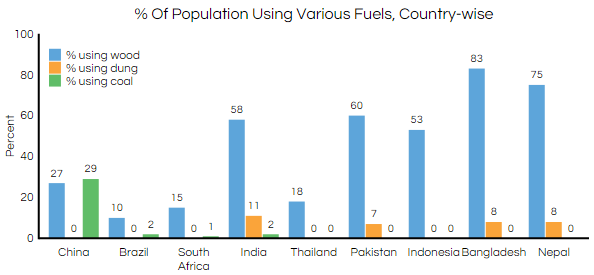
Source: CleanCookstoves.org
Expectedly, rural India consumes a much higher amount of solid fuels at 82%, although this is a slight reduction from 1990, when the total usage was 90%, according to this analysis.
There is a shift towards cleaner fuels, but it is slow. In 1993, 2% of the rural population used LPG; in 2010, Even if 12% of the rural population now uses LPG, that is still very low. In contrast, the population of LPG users in urban India went up to 65% in 2010 from 30% in 1993.
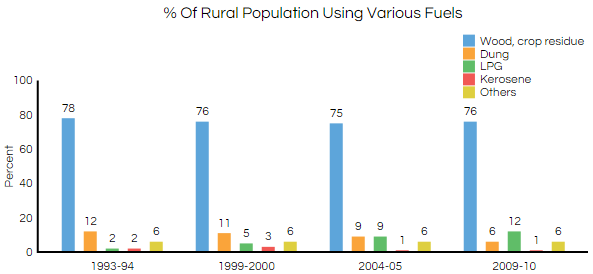
Source: CleanCookstoves.org; Figures in chart have been rounded
Ten states in India contribute to about 75% of the total solid-fuel use. Bihar leads with 90% of households using solid fuels, and Tamil Nadu with 44% is the least. Firewood is the most popular solid fuel across India.
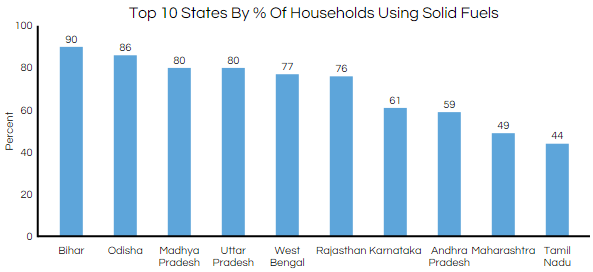
Source: CleanCookstoves.org
Darkening skies threatening Himalayas, poisoning lungs
Use of solid fuel not only damages the environment but has an adverse impact on health and society.
Burning solid fuels is the leading cause of household air pollution; smoke also travels outside causing ambient air pollution, according to this United Nations document.
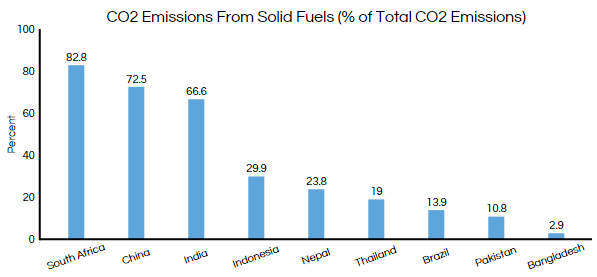
Source: World Bank
Burning solid fuels releases some of the most important contributors to climate change, carbon dioxide (CO2) and other short-lived climate pollutants. Products of incomplete combustion, methane and black- carbon particles, which are greater greenhouse pollutants than carbon dioxide, are also released.
Black carbon--the light-absorbing part of soot--is much better at trapping heat than CO2 and can travel long distances.
Black carbon is estimated to contribute the equivalent of a quarter to half of carbon dioxide globally. About 70%-80% of black carbon comes from households in developing countries. In South Asia, more than half of the black carbon comes from incomplete combustion of household solid fuel, according to the United Nations Environment Program.
Black carbon is a serious threat to the melting of glaciers and a grave concern in South Asia due to its potential impact on the Himalayas. Black carbon also disrupts the monsoons, which threatens water availability and food security.
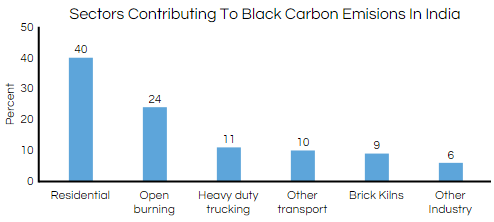
Source: United Nations Environment Programme
About 780 million people in India are affected by household air pollution, mainly caused by smoke from burning solid fuels for cooking, according to a report by the Global Alliance for clean cookstoves.
Women and young children are the most affected by the health problems associated with exposure to cookstove smoke, with more than 100,000 children in India dying every year, as a result of acute lower respiratory infections, including pneumonias, caused by soot from solid fuels.
Solid fuels emit substantial amounts of health-damaging pollutants,including particulates, carbon monoxide, nitrogen oxides, benzene, formaldehyde, 1,3-butadiene, and polyaromatic compounds such as benzo(a)pyrene.
Solid-fuel soot accounted for about 2.6% of illnesses worldwide in 2000, according to a global comparative risk assessment organized by the World Health Organisation (WHO).
Respiratory infections and chronic lung diseases, including chronic obstructive pulmonary disease are commonly associated with exposure to household pollution. Respiratory tract cancers and lung cancer are strongly associated with pollution from coal burning. There is also growing evidence of other effects on health from indoor-pollution, such as tuberculosis, cataracts, low birth-weight and heart disease.
Nearly 39% of early neonatal stillbirths were attributed to cooking fumes, according to this study that examined the relationship between biomass fuel-use and stillbirths in India.
Another study that collated epidemiological literature linking solid fuel use with a variety of health outcomes found strong evidence for acute lower respiratory infection in children, and chronic obstructive pulmonary disorder and lung cancer in adult women.
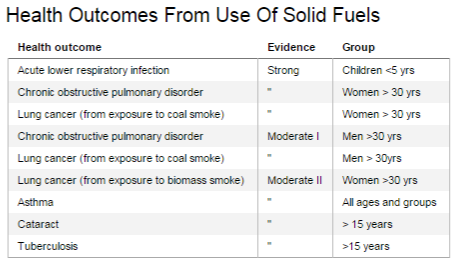
Source: World Health Organisation
Besides the impact on health and the environment, there is an effect on society too.
Gathering solid-fuel is time-consuming drudgery, taking away from other activities, such as childcare or school study.
Wood harvesting has led to pressure on natural resources and forests and increase in deforestation, which in turn causes reduced carbon uptake by trees. Unsustainable collection of wood can contribute to loss of forest canopy, mud-slides, and loss of biodiversity.
The search for a better stove and cleaner fuel
Improved stoves are the cheapest way of improving health, according to a WHO report.
In Africa and South and South-east Asia, the regions with the greatest number of people exposed to toxic soot, improved stoves could reduce the burden of disease associated with indoor air pollution for an average yearly cost of Rs. 30,000 to 37,000 per healthy year gained.
Several attempts have been made in the past by the Indian government to provide improved stoves.The National Program on Improved Chulhas (stoves), started in 1985, aimed at conserving fuel and reducing smoke by using chimneys. About 35 million stoves were installed, according to a study published in the journal Energy for Sustainable Development, but it was discontinued in 2002 because the stoves did not last or work well enough.
Another program, The National Biomass Cookstoves Initiative, was launched in late 2009 to distribute clean, energy efficient cookstoves. Several NGOs and private initiatives have in the recent years evolved new, improved cook stoves and distribution programmes.
Success has been partial, with less than a third of the solid fuel-using population switching to clean cookstoves.
“There are many challenges in getting people to shift from traditional to improved cookstoves," said Sudha Setty, Indian representative of The Global Alliance for Clean Cookstoves. "Women, who are the end users, are not decision makers, so male members need to be convinced. For them, economic benefits make more sense than health benefits.”
LPG would be an ideal substitute, but supply depots are expensive and--for people like Renuka--a cylinder is simply too costly.
(Deepa Padmanabhan is a Bangalore-based freelance journalist with an interest in health, environment, culture and development.)
____________________________________________________________
“Liked this story? Indiaspend.org is a non-profit, and we depend on readers like you to drive our public-interest journalism efforts. Donate Rs 500; Rs 1,000, Rs 2,000.”


